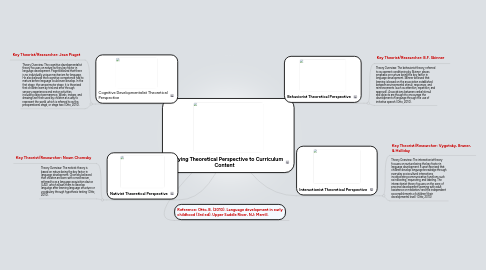Applying Theoretical Perspective to Curriculum Content
by Crystal Kallio

1. Behaviorist Theoretical Perspective
1.1. Key Theorist/Researcher: B.F. Skinner
1.2. Theory Overview: The behaviorist theory, referred to as operant conditioning by Skinner, places emphasis on nurture being the key factor in language development. Skinner believed that learning is based on the association established between environmental stimuli, responses, and reinforcements (such as attention, repetition, and approval). Associations between verbal stimuli and objects are thought to encourage the development of language through the use of imitative speech (Otto, 2010).
2. Nativist Theoretical Perspective
2.1. Key Theorist/Researcher: Noam Chomsky
2.2. Theory Overview: The nativist theory is based on nature being the key factor in language development. Chomsky believed that children are born with a mechanism, referred to as a language acquisition device (LAD), which allows them to develop language after learning language structure or vocabulary through hypothesis testing (Otto, 2010).
3. Cognitive Developmentalist Theoretical Perspective
3.1. Key Theorist/Researcher: Jean Piaget
3.2. Theory Overview: The cognitive developmentalist theory focuses on nature as they key factor in language development. Piaget believed that there is no individually unique mechanism for language. He also believed that cognitive competence had to mature before language could even develop. In the first stage, the sensorimotor stage, it is theorized that children learn by trial and error through sensory experiences and motor activities, including object permanence. Words, images, and drawings are then used by children as a way to represent the world, which is referred to as the preoperational stage, or stage two (Otto, 2010).
4. Interactionist Theoretical Perspective
4.1. Key Theorist/Researcher: Vygotsky, Bruner, & Halliday
4.2. Theory Overview: The interactionist theory focuses on nurture being the key factor in language development. It was theorized that children develop language knowledge through everyday sociocultural interactions, incorporating communicative functions such as indicating, requesting, and labeling. The interactionist theory focuses on the zone of proximal development (learning with adult assistance or mediation) and the independent accomplishments of children (their developmental level) (Otto, 2010).
5. Reference: Otto, B. (2010). Language development in early childhood (3rd ed). Upper Saddle River, NJ: Merrill.


